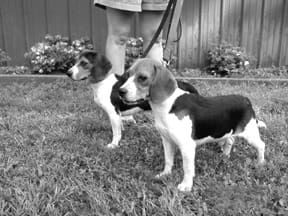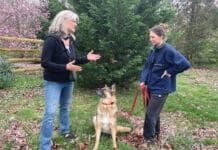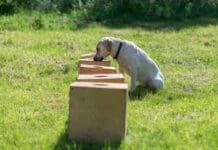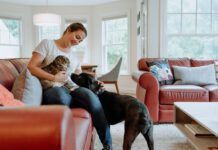[Updated February 5, 2019]
What do Russian tigers, mold, lost pets, cancer cells, bomb-making equipment, illegal drugs, tortoises, termites, and knapweed have in common? They are all subjects of innovative training programs that work with dogs to seek out a growing list of unique targets for our benefit.
Humans have taken advantage of dogs’ incredibly keen sense of smell over the ages for such uses as hunting, tracking lost and fugitive humans, and more recently, the detection of bombs, narcotics, and other contraband. It’s well known that a dog’s nose is many times sharper than our own – estimates range from 10,000 to 100,000 times superior to ours, with a far greater number and variety of scent receptors in their noses, more neurons linking the nose to the brain, and a greater proportion of their brains devoted to smell.
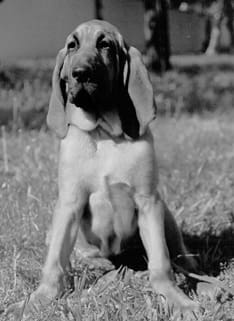
We accept this without question as we routinely utilize our dogs’ sense of smell to locate tennis balls we toss into deep grass in the dark; find treats and toys we stash around the house; search for us when we play hide-and-seek in the woods; and in Utility Obedience, retrieve the one item that has been handled by the owner out of a pile of identical-looking objects. Our dogs, if they ever thought about it, would have to conclude that we humans are seriously disabled in the nose department – we couldn’t even begin to come close to duplicating the feats that they accomplish without thinking twice about it!
In addition to the now-familiar uses for a dog’s smelling talent, trainers and researchers are only just starting to realize the best potential ways to make dog noses work for humans. For example, in 2002-2003, biologists in Russia trained dogs to help monitor a threatened species of tiger, the Amur Tiger, through a grant from the National Fish and Wildlife Foundation. The research team trained two dogs, not just to track tigers in general, but to actually identify individual tigers; one to 96 percent accuracy, the other to 89 percent accuracy.
Other new uses for dog noses include:
- Mold and termite detection for home repairs and sales
- Searching out desert tortoises (a threatened species) in the U.S. to help preserve critical habitat
- Locating an invasive, nonnative weed in Montana for eradication purposes
- Sniffing out the deadly venomous brown tree snake in produce shipments from Asia to prevent accidental international transport
- Detecting cancer cells in human urine for diagnosis and treatment
- Locating leaks in pipe lines
- Finding missing pets to prevent their suffering and allay human grief over the loss of beloved companions
- Alerting Forest Service personnel to the presence of masses of gypsy moth eggs, so the destructive pests can be eradicated before they mature, spread, and destroy forests
Which Dogs Have the Best Sense of Smell?
According to Dr. Larry Myers, canine scent expert and professor of veterinary medicine at Auburn University in Alabama, all dogs have noses good enough to do scent work. However, trainability and interest in doing the job are important qualities; just because a dog can do scent work doesn’t mean he will. For some kinds of work, the size of the dog and his coat length may determine suitability. (A large, heavy-coated dog may not be the best candidate for working in a desert, for example.)
Carole Schatz, CPDT, of San Diego, California, is the training director for a cancer detection study, still in the development phase, at Scripps Research Institute’s General Clinical Research Center. Dogs selected for the Scripps study include Schatz’s own dog, a Golden Retriever/Poodle mix, a Border Collie mix, Corgis, a Chihuahua mix, a Boxer, a Bernese Mountain Dog, an Italian Greyhound, German Shepherds, a Rhodesian Ridgeback, and an Aussie/Cocker mix. Schatz recruited the trainers for the program, and all the dogs are personal companions of the selected trainers.
In contrast is Hal Steiner of Bozeman, Montana, the owner of Rocky Mountain Command Dogs, a company that provides basic training services and also specializes in scent work. Steiner uses a specialized breed of dog that he created specifically for scent work purposes. He developed the “Rocky Mountain Shepherd” over decades, from Czech border patrol stock and hybrids of the red European wolf, and uses this breed almost exclusively for his scent work, although he does occasionally rescue dogs of other breeds that might be suitable for his purposes.
David Latimer, of Vincent, Alabama, owns FSI K9 Academy. In addition to training bomb, arson, narcotics, and tracking dogs, Latimer trains dogs to detect water leaks, mold, and termites. He uses small to medium-sized dogs such as Beagles, Rat Terriers, and Border Collies for mold and termite work; they fit better into some of the confined spaces where their quarry is sought. Most come from local shelters and rescue groups and some are donated. He rarely purchases a dog.
“I look for dogs who have what I call a strong ‘work ethic,’ says Latimer. “I want a dog with a high hunt drive and a high energy level coupled with a strong desire to please his handler. In addition, I look for dogs that are nonaggressive toward people and other animals.”
Kathy “Kat” Albrecht, of Clovis, California, too, follows the eclectic approach to scent dog selection for her “pet detective” work. A former police detective and search dog trainer/handler, Albrecht began a new career finding lost pets when injuries sidelined her from police work. She now specializes in training what she has dubbed “missing animal response” (MAR) search dogs that are trained and certified to locate various lost pets. Albrecht trains dogs for three types of work: MAR Cat Detection K9s detect live and deceased cats; MAR Specific Scent K9s can detect the scent of any missing animal within a confined search area; and MAR Trailing K9s are trained to discriminate the scent of a lost dog and follow the scent trail to establish direction of travel in hope of finding the missing dog.
“Dogs best suited for MAR work are fixated on one of three things: cats, treats, or other dogs,” she says. “For cat detection dogs we look for dogs who absolutely pine for kitties and give a physical response (tail-wiggles, butt-wag, etc.) when they detect a cat’s scent. For specific-scent dogs, we want dogs who will fixate their attention on a piece of hot dog and do anything for that hot dog, ignoring all distractions. For trailing dogs, we look for the “dog park” type of dog who loves to play with other dogs.”
Since Albrecht’s goal is to develop a system to train a massive corps of certified MAR K9 handlers around the world, she keeps an open mind about breed possibilities, with just a few limitations. Albrecht thinks that pug-nosed dogs (Pugs, Boxers, Pekinese, etc.), tiny dogs (Chihuahuas, Teacup Poodles, etc.) and giant breeds (Great Danes, Irish Wolfhounds, St. Bernards) are just not appropriate for MAR work due to their physical limitations. She also looks for dogs that are at least six months old and no older than eight years to enter the MAR training program.
Positive Training Techniques Ideally Suited for Scent Work
All of the trainers we interviewed agreed that scent work was trained most effectively using reward-based, positive training methods, although there were differences of opinion over whether the reward should be food treats or “life rewards,” such as the opportunity to play with a coveted toy.
As in every field of dog training, however, some of the trainers we spoke to hold fast to the notion that corrections are necessary during training, especially during the foundation “obedience” phase, in order to achieve reliability. The idea that there must be “consequences” for objectionable behaviors is difficult for many old-fashioned trainers to get past.
In contrast, we have found that the use of “negative punishment” (the removal of a desired object or outcome to decrease unwanted behavior) is a gentle but effective consequence that, in combination with positive reinforcement, can produce very dependable work dogs.
Carole Schatz, Certified Pet Dog Trainer and training director for a study at Scripps Research Institute’s General Clinical Research Center for canine detection of cancer, told us why she uses primarily positive reinforcement in her training and sought out trainers with a similiar training philosophy to participate in the study:
“In the 1960s I was a reading teacher,” Schatz says. “My kids learned the fastest because I bought pretzels. Each child was tested daily and if they learned the lesson, they earned a pretzel. My kids were always the first ones to learn to read. Thus, when I went into dog training in 1975, I was completely open to using positive rewards – goodies. It was lonely until I met Dr. Ian Dunbar in 1978 and traveled to his classes and seminars. Here was validation.
“I love it when the dogs learn fast and have fun doing it. It also gives me great pleasure to see their happiness. It’s win/win. Using punishment makes the dog fearful and unhappy and then I’m unhappy. It also takes longer because you have by-products of fear and confusion.
“The training methods involved in this study are no different than training anything else – ignore the wrong and reward what’s right. My goal is happy dogs who love what they’re doing and happy trainers. Alerting to cancer is frosting on the cake.”
Scent Work Training Methods and History
While scent dogs are trained primarily with methods that focus on positive reinforcement, there is considerable variation as to how that operant principle is applied.
Cancer detection is a very new field of canine scent work. A study in England published in the British Medical Journal in September 2004 described how six pet dogs were trained to alert to the urine of patients with bladder cancer. The results of a double-blind test of the dogs at the conclusion of a seven-month training period showed the dogs successfully alerted to the urine of patients with bladder cancer 41 percent of the time (14 percent would represent a random response).
The researchers involved with the study, including trainers from Hearing Dogs for Deaf People and medical researchers from the Erasmus Wilson Dermatological Research Fund, feel they have not only demonstrated the promise of this form of cancer detection, but also designed a successful training protocol and stringent controls in the testing phase suitable for extending the work. Their future goals are to optimize the experimental process and to study the potential for dogs to detect other types of cancers, particularly skin cancer.
A study that will be conducted in this country at Scripps Research Institute’s General Clinical Research Center is still in the development stages. Trainer Carole Schatz and Dr. Robert Gordon are collaborating with Dr. Larry Myers, canine scent expert and professor of veterinary medicine at Auburn University in Alabama. The Scripps study will attempt to teach 12 dogs to alert to an odor signature in the urine of patients with prostate and breast cancer. One of these dogs is Schatz’ own two-year-old Golden Retriever/Poodle mix, Josie. Josie is already a certified assistance dog and a registered therapy dog.
The dogs in the Scripps program will be trained with various positive methods. “Every dog is an individual,” says Dr. Robert Gordon, principal investigator for the Scripps study. “We have to learn which technique works best with each individual dog.”
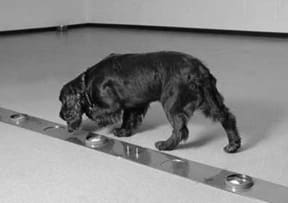
Dog trainers in the study are given latitude to experiment with their own training techniques to see what works best. Some are training their dogs to alert to the scent of vanilla. The alert signal is then transferred to the presence of the odor signature of cancer in urine. In a separate study being conducted by Dr. Myers at Auburn University, dogs are first trained to alert to the banana-like scent of n-amyl acetate, then transitioned to cancer cells.
One of the questions the researchers hope to answer is whether the cancer substances that are excreted in urine are universal to all cancers, or specific to individual cancers. For example, prostate cancer may be aggressive or nonaggressive, and there is currently no way to tell which is which. If dogs could be trained to distinguish the difference, it could make a big difference in how the cancers are treated.
“There is real scientific, humanistic value in this project,” Dr. Gordon says excitedly. “If this project proves out, we could train teams to go places where modern diagnostic equipment isn’t available. This could make a huge difference in the quality of peoples’ lives.” In between training sessions, the cancer detection dogs live normal lives, or as Schatz says, “They are all pets.”
Smelling Weeds for a Purpose
Kim Goodwin, a rangeland noxious weed specialist with Montana State University, contacted scent dog trainer Hal Steiner in 2003. She asked if he could train dogs to detect knapweed in the field, and Steiner agreed to give it a try. He selected a Rocky Mountain Shepherd (a breed he developed himself) to be the test dog for the project. The dog was so successful, he later dubbed her “Knapweed Nightmare.”
Phase One of the knapweed detection program was successfully completed and field-tested in the fall of 2004. At completion of the testing, Nightmare was finding the nonnative invasive plant with a 93 percent success rate, proving that dogs can detect low densities of the invasive plant efficiently. Steiner sold Nightmare to the university, which is now seeking funding to continue the work.
Steiner, while still using primarily positive training methods for the scent work, takes a different approach. From the time his professional working dogs are born, they never “play” the way a companion dog might.
“She’s not a pet; she’s not played with,” Steiner says of Nightmare. “We start with basic obedience training, using corrections if necessary. Then, using ‘game theory,’ we addict the dog to a certain type of toy, in Nightmare’s case a towel or piece of plastic tubing with knapweed wrapped inside. When she’s not working, she’s in her pen.”
Handlers in Steiner’s program praise the dog – no food rewards – when she reacts to the scented toy. Steiner then hides the toy in places that are progressively harder to sniff out. As Nightmare becomes proficient, the trainers add distractions, to teach her to stay focused on her task.
The Rocky Mountain Shepherd was also trained to indicate her finds by digging at a spot of knapweed for 10 seconds so the global positioning system (GPS) attached to her collar could mark the location of a knapweed find.
“You don’t want bomb dogs digging aggressively at a package of explosives,” Steiner chuckles. “We want them to indicate finds gently. But Nightmare needed to stay in position for 10 seconds (for the GPS unit to record the spot), and the easiest way to get her to do that was to encourage her to find aggressively, by digging at the spot for a bit, then moving on. Humans check the spot later to confirm the find.”
Pest Detection
David Latimer tells us that dogs have been doing termite detection for at least 20-25 years in the U.S. Mold detection developed originally in Europe about 10 years ago. Latimer uses positive reinforcement, and acknowledges the importance of timing when rewarding desired behaviors. He also subscribes to what he calls “fair and just discipline” as a part of training dependable working dogs.
Among other training exercises, Latimer uses a “scent board.” This is a piece of 2×4 with eight, 4- to 6-inch sections of PVC pipe attached vertically, secured with screws to the board. Each section of pipe is capped with a screw-on cap to conceal the contents; the caps have small holes drilled through the center to release the scent. The target odor – termite-infested or moldy material – is placed inside one or two of the pipes, and distracting odors are placed in several of the other pipes. In order to earn a reward, the dog must correctly identify which pipe or pipes contain the target odor.
Finding Lost Pets (People Too)
Kat Albrecht says that the use of dogs specifically for finding lost pets goes back to the 1970s, when a Bloodhound handler in Texas used his dogs to search for missing dogs. This trainer reportedly died in the early 1980s, and while an occasional search dog may have been used for this purpose since then, no one until Albrecht has attempted to do it on a large, formal scale.
Today Albrecht is the founder of Pet Hunters International, the world’s first pet detective academy, and Missing Pet Partnership, a nonprofit organization that provides training for animal welfare organizations and conducts research into the behavioral patterns of lost pets. Albrecht is also the author of The Lost Pet Chronicles, a nonfiction book about her work.
For cat detection dogs, Albrecht conceals gregarious, dog-friendly cats in a crate in some shrubbery, and rewards dogs for responding to the scent of the cat. Dogs are reinforced for giving a physical alert to the presence of the cat, then encouraged to run back to and jump on the handler, then do a “re-find” by taking the handler back to the crated cat, where they are rewarded. The reward in this case is treats plus the opportunity to play with the uncrated, harnessed and leashed cat.
For the specific scent training, Albrecht uses a clicker to teach dogs to search for treats by sniffing a sterile gauze pad that contains the matching treat scent. She progresses to hiding baby food jars with various scents, and uses the gauze pad to teach “smell this smell, find this smell.”
Her dog-trailing dogs are trained using a modification of the method used to train Bloodhounds to follow the scent trail of a human, only using a scent article from a “target dog.” The reward for the scent dog is to play with the dog he finds!
Success Stories
Latimer likes to tell about one of his handlers who was called to do a real estate purchase inspection on a lake house, and had the dog alert on an area outside the home. “Upon investigation,” Latimer relates, “the handler found that extensive termite damage had been cosmetically concealed prior to his arrival. Apparently another company had found the termite infestation on an earlier inspection, and the homeowner tried to conceal it from the handler in order to get a termite clearance.”
Albrecht’s favorite story included the participation of her cat, Yogi, as an impromptu pet detective. As Albrecht walked out of her house one morning, she noticed Yogi sniffing a spot in the road, unusual for the cat, who was normally terrified of the roadway. That evening, when Albrecht’s neighbor mentioned that her cat, Rocky, was missing, Albrecht remembered Yogi’s unusual behavior.
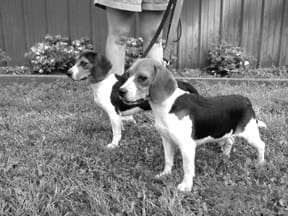
Albrecht took her Weimaraner, Rachel, a retired cadaver dog, out to look for blood in the roadway. Rachel urinated on the road – her somewhat unorthodox alert indicating that she’d found decomposing blood or tissue. Her find suggested to Albrecht that the cat was injured, not just lost or stolen, which prompted her to suggest the owner focus her search within the cat’s territory.
“Sure enough,” says Albrecht, “Andrea found Rocky under his deck, one back leg hanging by a thread, but alive. Rocky is now a happy three-legged kitty who was saved because of his curious neighbor cat and a trained search dog.”
As these programs gain momentum, and as trainers develop more programs that use our dogs’ incredible sense of smell, we will no doubt hear of more exciting ways that dogs can demonstrate their value. Most exciting to us is the comment of many trainers, that “any dog” can do scent work. That means you and your dog can do it too! Remember, if it has a scent, a dog can be trained to find it. The possibilities are endless.
SCENT WORK FOR DOGS: OVERVIEW
1. Test your dog’s interest in scent work by hiding his favorite toy, initially while he’s watching, and then, once he understands the “game,” in places he has to use his nose to find it.
2. Reward your dog’s successful location of a hidden item or family member with “high-value” treats, whether that means bits of fresh chicken or playing with a tug toy.
3. If he shows consistent interest and/ or talent at using his nose, shop for books and videos on training a scent dog.
Pat Miller, CBCC-KA, CPDT-KA, is Whole Dog Journal‘s Training Editor. She is also author of The Power of Positive Dog Training, and Positive Perspectives: Love Your Dog, Train Your Dog.


